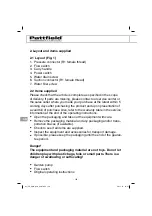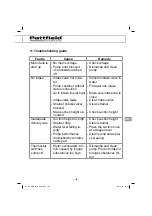
GB
- 160 -
5.2 Connecting the intake line
•
Fasten the suction hose (at least approx. 19 mm (¾“) plastic hose
with spiral reinforcement) to the suction connection (5) approx.
33.3 mm (R1 female thread) of the equipment either directly or via
a threaded nipple.
•
The suction hose used should be equipped with an intake valve.
If the intake valve cannot be used, a non-return valve should be
installed in the intake line.
•
Position the intake line so that it rises from the water withdrawal
point to the equipment. Avoid positioning the intake line higher
than the pump, as this would delay the escape of air bubbles from
the intake line and impede the priming process.
•
Install the intake and discharge lines in such a way that they do
not exert any mechanical pressure on the equipment.
•
The intake valve should be low enough in the water to ensure that
if the water level falls, the unit will not run dry.
•
A leaking intake line will draw in air and therefore not draw in any
water.
•
Prevent the intake of foreign bodies (sand, etc.). If necessary, ins-
tall a coarse filter for this purpose.
5.3 Connecting the discharge line
•
The discharge line (min. 19 mm (¾“)) must be connected to the
33.3 mm (R1IG) female thread discharge line connector (1) of the
equipment either directly or with the aid of a threaded nipple.
•
With the right couplings it is also possible, of course, to use a 13
mm (½ “) delivery hose. The smaller delivery hose results in a lo-
wer delivery rate.
•
During the priming operation, fully open any shut-off mechanisms
(spray nozzles, valves, etc.) in the pressure line so that the air can
escape without obstruction.
Anl_PE_HWA_650_SPK7.indb 160
Anl_PE_HWA_650_SPK7.indb 160
26.11.15 14:21
26.11.15 14:21











































